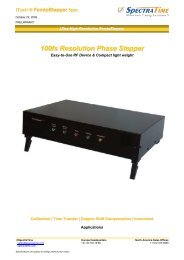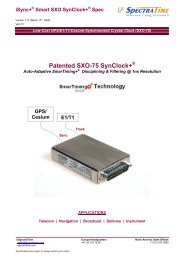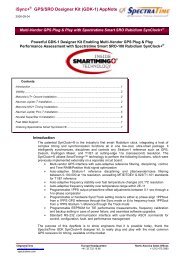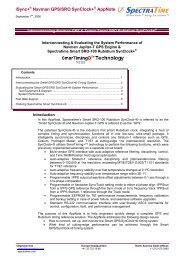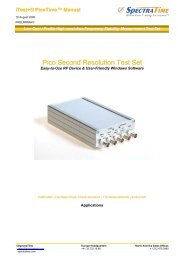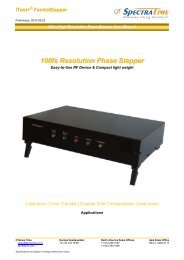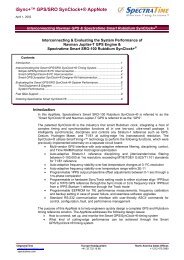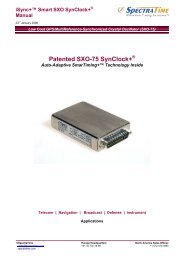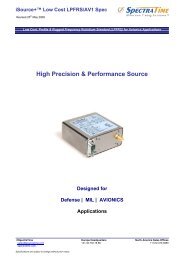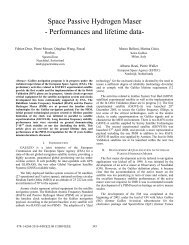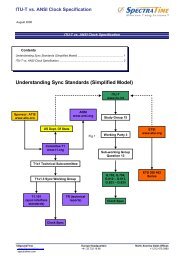RMO Manual - Spectratime
RMO Manual - Spectratime
RMO Manual - Spectratime
You also want an ePaper? Increase the reach of your titles
YUMPU automatically turns print PDFs into web optimized ePapers that Google loves.
iSource+ Low Cost <strong>RMO</strong> <strong>Manual</strong>30 th November 2006Low Cost Rubidium Master Oscillator (<strong>RMO</strong>)High Precision & Performance SourceTelecom | Navigation | Broadcast | Defense | InstrumentApplications©SpectraTime Europe Headquarters North America Sales Officessales@spectratime.com +41.32.732.16.66 +1.512.470.3980spectratime.com
iSource+ Low Cost <strong>RMO</strong> <strong>Manual</strong>Table of Content :1. INTRODUCTION ..............................................................................................................................................................32. <strong>RMO</strong> SYSTEM DESCRIPTION ........................................................................................................................................32.1 PRINCIPLE OF OPERATION AND BASIC CONFIGURATION.................................................................32.2 PHYSICS PACKAGE ..................................................................................................................................42.3 ELECTRONICS PACKAGE ........................................................................................................................52.3.1 PRINCIPAL FUNCTIONS OF THE ELECTRONIC CIRCUITS ............................................................53. <strong>RMO</strong> SPECIFICATIONS ..................................................................................................................................................84. <strong>RMO</strong> INSTALLATION AND OPERATION .......................................................................................................................84.1 INTRODUCTION..........................................................................................................................................84.2 SHIPPING AND RECEIVING INFORMATION............................................................................................84.3 MOUNTING..................................................................................................................................................94.4 PIN FUNCTION LAYOUT..........................................................................................................................114.5 NORMAL OPERATION.............................................................................................................................114.6 SERIAL INTERFACE OPERATION..........................................................................................................114.6.1 INTRODUCTION ................................................................................................................................114.6.2 SERIAL INTERFACE CONNECTION ................................................................................................124.6.3 <strong>RMO</strong> INTERNAL PARAMETERS MONITORING ..............................................................................124.6.4 CENTER FREQUENCY ADJUSTMENT WITH THE SERIAL INTERFACE ......................................134.6.5 CENTER FREQUENCY READ-BACK ...............................................................................................144.7 LOCK MONITOR and XTAL MONITOR OUTPUTS.................................................................................144.7.1 TTL OR CMOS LEVEL ‘LOCK MONITOR’ GENERATION................................................................144.7.2 TYPICAL <strong>RMO</strong> CONNECTION INCLUDING FREQUENCY ADJUSTMENT AND 'LOCK' LED .......15ANNEX I: RS232 ADAPTER CIRCUIT 23©SpectraTime Europe Headquarters North America Sales Offices Page 2 of 15sales@spectratime.com +41.32.732.16.66 +1.512.470.3980spectratime.com
iSource+ Low Cost <strong>RMO</strong> <strong>Manual</strong>1. INTRODUCTIONThe Models <strong>RMO</strong> XX Rubidium Ultra-Stable Oscillators are sub-miniature, atomic resonance-controlledoscillators that provide an extremely stable frequency of 5, 10 or 20 MHz (sinusoidal) or any other frequencywhen <strong>RMO</strong> is equipped with its build-in output synthesizer option. The <strong>RMO</strong> is designed for navigation ,communication and timing instruments requiring such extremely stable and precise frequency .This manual contains information about the operation and field maintenance of the <strong>RMO</strong>.Chapter 2 contains a general description of the unit. It also presents a basic theory of operation for a technicianor engineer who requires a better understanding of the unit's operation.Chapter 3 lists all specifications and operation requirements of the <strong>RMO</strong>.Chapter 4 gives information on how to install and operate the unit. It is recommended that these chapters beread prior to operate the unit. This chapter describes also the possible interface connection for the monitoring ofthe internal parameters and for the center frequency adjustment.2. <strong>RMO</strong> SYSTEM DESCRIPTION2.1 PRINCIPLE OF OPERATION AND BASIC CONFIGURATIONThe <strong>RMO</strong> essentially consists of a voltage-controlled crystal oscillator (VCXO) which is locked to a highly stableatomic transition in the ground state of the Rb87 isotope. While the frequency of the VCXO is at the convenientstandard frequency of 10 MHz, the Rb clock frequency is at 6.834XXX GHz in the microwave range. The linkbetween the two frequencies is done through a phase-stabilized frequency multiplication scheme whereby asynthesized frequency is admixed to enable exact matching.The Rb atoms are confined in a vapor cell at an elevated temperature. The cell is placed in a microwaveresonator to which the microwave power derived from the VCXO is coupled. The Rb87 atoms in the cell occurwith equal probability in the two hyperfine energy levels of the ground state (F=1 and F=2).In order to detect the clock transition between these two levels, the atoms need to be manipulated in such away that most of them occur in only one level. This is done by optical pumping via a higher lying state (P). Fig.2-1 visualizes the atomic energy levels and transitions involved in the optical pumping process.Fig. 2-1: Energy levels and transitions in Rb87 atoms during <strong>RMO</strong> operation©SpectraTime Europe Headquarters North America Sales Offices Page 3 of 15sales@spectratime.com +41.32.732.16.66 +1.512.470.3980spectratime.com
iSource+ Low Cost <strong>RMO</strong> <strong>Manual</strong>The pump light comes from a Rb resonance lamp which emits the light of Rb87 atoms. This light, whichintersects the absorption cell, is filtered in such a way that mainly one optical frequency, which corresponds to atransition out of one of the two ground state levels (line A), enters the principal absorption region.The pump light excites Rb87 atoms which are in the lower hyperfine level (F=1) to the short-lived excited stateP from which they decay to the two ground state levels (F=1,2) with equal probability. Since pumping occurscontinuously out of the F=1 level, after some time, almost all atoms are found in the F=2 level and no furtherabsorption occurs.The transmitted light level is detected by a photodiode after the cell. If now a microwave field resonant withclock transition F=2® F=1 is coupled to the interaction region, the level F=1 is repopulated and light absorptionis enhanced. A sweep of the microwave field over the resonance is detected as a small dip in the transmittedlight level after the cell.This signal is fed into a synchronous detector whose output generates an error signal which corrects thefrequency of the VCXO when its multiplied frequency drifts off the atomic resonance maximum.The absorption cell is filled with metallic vapor which contains Rb85 and Rb87 isotopes and a buffer gas.Filtering of the pump light is achieved in the entrance region of the cell by absorption with Rb85 atoms whichhave an accidental overlap with one of the Rb87 resonance transitions (line B): integrated filter cell.Fig. 2-2: Rubidium atomic clock principal block diagramThe principal function of the buffer gas is to keep the Rb atoms away from the cell walls and restrict theirmovements. As a result they are practically "frozen in place" for the interaction time with the microwave field. Inthis way the Doppler-effect is virtually removed and a narrow line width results.The cell region is also surrounded by a so-called C-field coil which generates a small axial static magnetic fieldto resolve the Zeeman sub-transitions of the hyperfine line and select the clock transition, i.e. the one with theleast magnetic sensitivity. To further reduce the magnetic sensitivity, the complete physics package is placedinto nested magnetic shields.Fig. 2-2 gives a basic overview of the different function blocks of the Rubidium atomic clock. The <strong>RMO</strong> consistsof three different packages. The optical elements, which include the Rb absorption cell and microwave cavity,form the atomic resonator, while the electronics package is constituted of the generator and the detectioncircuitry.2.2 PHYSICS PACKAGEThe main design characteristics of the physics package are its low power consumption, small size and mass,along with minimal environmental sensitivities and mechanical ruggedness.All parts of the physics package are incorporated in a aluminium tube surrounded by magnetic shields. Insidethis tube, lamp and cell sections form two separate blocks which operate at well-defined but differenttemperatures. The cylindrical tube is filled with polyurethane foam for low thermal conductivity. The lamp andcell sections are separated with a glass window. This configuration greatly reduces the thermal flow betweenthe blocks and the tube envelope. It allows a very compact design with low power consumption, short warm-uptime and minimal environmental sensitivities.©SpectraTime Europe Headquarters North America Sales Offices Page 4 of 15sales@spectratime.com +41.32.732.16.66 +1.512.470.3980spectratime.com
iSource+ Low Cost <strong>RMO</strong> <strong>Manual</strong>Other design features which contribute to the compact design are:- use of the integrated filter technique (IFT)- use of a magnetron-type microwave resonatorThe integrated filter technique which combines the optical filtering and pumping in one cell contributes also tothe reliability since the configuration is simplified and the number of components reduced. The thermalcapacitance of the cell assembly is relatively low. As a consequence, the necessary power during warm-up isgreatly reduced.The magnetron resonator is a cylindrical cavity loaded with a concentric capacitive-inductive structure (annularmetal electrodes). It allows smaller cavity dimensions and concentrates the microwave field at the right regionof the cell.The Rb lamp is an electrode-less RF-discharge lamp: a heated glass bulb which contains Rb and a starter gassurrounded by an RF-coil.Although the atomic clock transition frequency is inherently quite stable, there are second order influenceswhich affect the frequency, i.e. temperature (buffer gas), light intensity (light shift = optical Stark effect),magnetic field (2nd order Zeeman effect). As a consequence, the temperatures of lamp and cell, the power ofthe lamp oscillator and the current in the C-field coil have to be carefully stabilized.2.3 ELECTRONICS PACKAGE2.3.1 PRINCIPAL FUNCTIONS OF THE ELECTRONIC CIRCUITSThe clock transition of a Rb resonator is a microwave transition at 6.834 .. GHz.The microwave resonance occurs as a dip in the optical signal; i.e. in the Rb lamp light which, after transitingthe cell, is detected by a photodiode.The basic purpose of the electronics package is to synchronize the ingoing microwave frequency, derived froma quartz crystal oscillator, to this absorption dip. This is achieved by tuning the microwave frequency tomaximum optical absorption.Frequency variations of the microwave signal are transformed into DC current changes at the photo-detector.The dip, visualized in the photocurrent versus microwave frequency curve of Fig. 2-3, is very small: on the orderof 1% of the total photocurrent which is however approximately 10 times higher compared to other commercialrubidium standards on the market.Since DC detection of the dip is not feasible , an AC detection method is used for the following reasons:- The dip amplitude is very small compared to the total photocurrent.- The slope of the derivative of the dip photocurrent versus microwavefrequency corresponds to roughly 1 nA/Hz. AC detection is the only solutionto have a good signal/noise ratio since the photo-detector with associated amplifierare affected by flicker noise.The AC method involves square wave frequency modulation of the microwave signal at a rate of fm~330 Hz. Asshown in Figure 2-3 the modulated microwave frequency flips between 2 discrete frequency values f1 et f2. Theresulting photo- current i(t) appears then also (after the transient )at 2 discrete values i1 and i2 .The difference between i1 and i2 produces the error signal used for the quartz crystal center frequencyadjustment until the mean value of f1 and f2 is exactly equal to the rubidium hyperfine frequency.The clock microwave frequency of the Rb atoms in the vapor cell has a nominal value of 6834.684 MHz . Thisfrequency is generated from a voltage controlled quartz oscillator (VCXO) which is multiplied up to 90 MHz.©SpectraTime Europe Headquarters North America Sales Offices Page 5 of 15sales@spectratime.com +41.32.732.16.66 +1.512.470.3980spectratime.com
iSource+ Low Cost <strong>RMO</strong> <strong>Manual</strong>Multiplication from 90 MHz to 6840 MHz is accomplished in one stage (x76 ) using a step-recovery diodemounted in the magnetron resonator inside the physics package.Fig. 2-3: Dip minimum detectionThe 5.316... MHz phase modulation is introduced at the 90 MHz level. The 5.316... MHz spectrum is thusreproduced as a sideband of the 6840 MHz signal multiplied from the 20 MHz VCXO. The difference of the twofrequencies corresponds to the Rb clock frequency.This 5.316... MHz is generated by a synthesizer which is frequency modulated at the rate of fm for dipdetection.The center frequency of the synthesizer is adjustable with step sizes of 12mHz in order to have the capability toadjust the <strong>RMO</strong> output frequency (10 MHz ) with a resolution of 1× 10-9 per step and, also, to compensate thefrequency shift due to the buffer gas pressure inaccuracies in the cell.The Rb light is generated by a plasma discharge in the Rb lamp. This is sustained by an RF oscillator whichdrives a coil surrounding the Rb lamp bulb. In addition, the lamp is heated to 140°C and stabilized within 0.2°Cover the full operating temperature range. The temperature controlled heating power is generated by a woundresistive heater wire. Another part of the heating power is generated by the RF oscillator.The Rb absorption cell is heated to ~85°C and also stabilized within 0.3°C over the full operating temperaturerange. The heating by a heater wire and the temperature control follows the same pattern as for the lampheater.©SpectraTime Europe Headquarters North America Sales Offices Page 6 of 15sales@spectratime.com +41.32.732.16.66 +1.512.470.3980spectratime.com
iSource+ Low Cost <strong>RMO</strong> <strong>Manual</strong>Fig. 2-4: <strong>RMO</strong> block diagramThe C-field coil within the physics package generates a magnetic field necessary for Rb spectral linesseparation. This magnetic field allows fine tuning of the 10MHz output frequency by shifting the Rb frequencyhyperfine transition by the second-order Zeeman effect.A high stability current generator drives this coil; it is adjustable by the user in order to attain a fine analog ornumerical resolution via a digital-to-analog converter.The user interface consists of the RS-232 port for the monitoring of the internal parameters and for the centerfrequency adjustment. In addition, an analog frequency control input is available to the user for centerfrequency adjustment by external potentiometer or external digital to analog converter.The correct operation of the unit can be checked by a single open collector type output signal called ‘ lockmonitor’. This lock monitor information is generated by the micro-controller and is a function of the followingparameters:- Light level intensity- Rb signal level (detected signal)- Heaters supply voltages- RF section health.The different alarm threshold levels corresponding to the different internal <strong>RMO</strong> electronics and physicsparameters are programmed during the automatic adjustment procedure at the factory.The power section of the <strong>RMO</strong> consists of three dc-dc converters. One is used for generating the internal 5Vneeded by the logic circuitry, the two other converters are used for the lamp and the cell heaters.The synchronization of the three converters is achieved by the use of a common ramp generator given by aninternal 125kHz signal derived by direct division of the 20 MHz main VCXO.©SpectraTime Europe Headquarters North America Sales Offices Page 7 of 15sales@spectratime.com +41.32.732.16.66 +1.512.470.3980spectratime.com
iSource+ Low Cost <strong>RMO</strong> <strong>Manual</strong>A detailed block diagram of the <strong>RMO</strong> is given by Fig. 2-4.3. <strong>RMO</strong> SPECIFICATIONSfollow this link4. <strong>RMO</strong> INSTALLATION AND OPERATION4.1 INTRODUCTIONThis chapter of the manual contains information regarding the installation and operation of the TNT Model<strong>RMO</strong>. It is recommended to read this chapter carefully prior to operate the unit.4.2 SHIPPING AND RECEIVING INFORMATIONThe <strong>RMO</strong> is packaged and shipped in a foam-lined box. The unit is inspected mechanically and electrically priorto shipment. Upon receipt of the unit, a thorough inspection should be made to ensure that no damage hasoccurred during shipping. If any damage is discovered, please contactSPECTRATIME SAPHONE: +41 32 732 16 66FAX: +41 32 732 16 67CH-2000 NEUCHATEL / SWITZERLANDShould it be necessary to ship the unit back, the original case and packing should be used. If the original caseis not available, a suitable container with foam-packing is recommended.CAUTIONCare must be taken for the transportation of the <strong>RMO</strong> to ensure that the maximum acceleration due to a choc50g/ 18ms is not exceeded.<strong>RMO</strong> contains glass bulbs, crystal resonators and crystal filters.When <strong>RMO</strong> integrated into an instrument, such instrument shall be packed in a suitable container, similar tocontainers generally use for the transportation of instruments like scope, video display or computer.©SpectraTime Europe Headquarters North America Sales Offices Page 8 of 15sales@spectratime.com +41.32.732.16.66 +1.512.470.3980spectratime.com
iSource+ Low Cost <strong>RMO</strong> <strong>Manual</strong>4.3 MOUNTINGThe unit should be mounted in preference to a PCB equipped with connection metalled holes of 1.2 to 1.5 mmdiameter. Mounting screws (2 x M3, stainless steel 5mm maxi into the <strong>RMO</strong> box) should be tightened with atorque between 50 Ncm and 100 Ncm.The heat transfer characteristics of the mounting surface must be adequate to limit the rise of the unit's baseplate to
iSource+ Low Cost <strong>RMO</strong> <strong>Manual</strong>The general information for the mechanical interface of the <strong>RMO</strong> unit is given in the package drawing of Fig. 4-3Fig. 4-3©SpectraTime Europe Headquarters North America Sales Offices Page 10 of 15sales@spectratime.com +41.32.732.16.66 +1.512.470.3980spectratime.com
iSource+ Low Cost <strong>RMO</strong> <strong>Manual</strong>4.4 PIN FUNCTION LAYOUTThe complete pin layout is given in figure 4.4.PIN FUNCTION1 RF output2 Vref / lock indicator3 ground4 Frequency control input5 Power supply6 RxD (TTL) (optional)7 TxD (TTL) (optional)Fig. 4.44.5 NORMAL OPERATIONWhen 12 Vdc (or 24V) is applied to pins 5 (+) and 3 (-), the unit will immediately begin to generate a 10 MHzsignal from the crystal oscillator. Within approximately 8 minutes (standard version) after application of inputpower the unit will "lock". Hence the crystal is now stabilized by the atomic resonant frequency.The unit is able to provide a single signal called ‘lock monitor’ (pin 2) which toggles to high level (+5V reference)when the internal crystal oscillator is locked to the Rb atomic resonance. (see chapter 4.7).The centerfrequency can be adjusted by external potentiometer using this internal voltage reference available on same pin2.ANALOG FREQUENCY ADJUSTMENTThe <strong>RMO</strong> is equipped with an analog frequency adjustment circuit which provides center frequency adjustmentby applying an external voltage of 0 to 5V on Pin 4.<strong>RMO</strong> standard frequency pulling range for 0 to 5V is ~2.5 x 10 -9. This pulling range can be expended byapplying up to ±10V to this pin.This analog voltage can be generated with an external potentiometer connected to Vref / lock indicator andGND (see pin function layout).4.6 SERIAL INTERFACE OPERATION4.6.1 INTRODUCTIONThe <strong>RMO</strong> is equipped with a microcomputer, associated with multi-channel D/A converters, used for setting itsparameters. This microcomputer is also used for the interrogation and detection of the Rb absorption ‘ dip’.The built-in serial interface allows an automatic parameter adjustment during the manufacturing process as wellas coarse and fine adjustment of the center frequency.All the working parameters are stored in a built-in EEPROM memory. In addition an 8 channel A/D converter isused for monitoring the main internal signals such as: light level, signal level, thermostats heating currents etc...©SpectraTime Europe Headquarters North America Sales Offices Page 11 of 15sales@spectratime.com +41.32.732.16.66 +1.512.470.3980spectratime.com
iSource+ Low Cost <strong>RMO</strong> <strong>Manual</strong>4.6.2 SERIAL INTERFACE CONNECTIONThe data transfer from the <strong>RMO</strong> can be made by direct connection to a PC or standard terminal.The data transfer parameters are the following:bit rate: 1200 bits/s.parity: nonestart bit: 1data bits: 8stop bit: 1IMPORTANT NOTE:In most cases, the serial PC interface accepts the 0 to 5V level and a direct connection can be made. In casethis 0 to 5V standard is not working , please refer to the small adaptation circuit called ‘RS 232 adapter circuit’described in annex I.4.6.3 <strong>RMO</strong> INTERNAL PARAMETERS MONITORINGIf pins 6 and 7 are present (standard), it means that your <strong>RMO</strong> has RS-232 operation capabilities.The internal parameters monitoring is made via the serial interface and with the use of a single command ‘M‘followed by a carriage return character.The <strong>RMO</strong> will respond to this single character command with an eightASCII / HEX coded string which looks like:HH GG FF EE DD CC BB AA (FF:not used)Where each returned byte is an ASCII coded hexadecimal value, separatedby a character. All parameters are coded at full scale.• DC-Voltage of the photocellHH: DC-Voltage of the photocell (0 to 5V for FF to 00)This signal corresponds to the transmitted Rb light level. This is the light of the Rb lamp which is partlyabsorbed by the Rb cell.The nominal photocell voltage is in the range 2.0 to 3.5 V but must stay stable after the warm-up time.The photo cell voltage is related to the internal reference 5 V voltage.The full scale corresponds to the coded value ‘00’ and the zero (no light) corresponds to the coded value‘FF’• Rb signal levelGG: Peak voltage of Rb signal level (0 to 5V for 00 to FF)This signal monitors the rectified value of the AC signal produced by the interrogation process of the Rb dipabsorption .During warm-up time this signal is approximately 0V and after it stabilises to a nominal value of 1 to 3.3V.As long as this signal is too low (
iSource+ Low Cost <strong>RMO</strong> <strong>Manual</strong>• Varactor control voltage (VCXO control)EE: VCXO control voltage (0 to 5V for 00 to FF)This parameter corresponds to the voltage applied to the varicap of the internal VCXO.In normal operation this voltage is mainly temperature dependent in the range 2 to 3V in order tocompensate the frequency versus temperature characteristic of the crystal resonator.During warm-up the control unit generates a ramp of this parameter from 0.3 to 5V and from 5V to 0.3Vuntil the Rb dip absorption is found.• Frequency adjustment voltageDD: o/p frequency adj. voltage (0 to 5V for 00 to FF)This parameter corresponds to the frequency adjustment voltage provided by the user .This information can be used for a read-back of the actual voltage applied to pin 2 of the <strong>RMO</strong> connector.• Rb lamp heating limiting currentCC: Rb lamp heating limiting current (500mA to 0mA for 00 to FF)This parameter corresponds to heating limiting current applied to the lamp heating resistive element.In normal operation, this current depends on the ambiant temperature but should stay between 1A and E6.During warm-up, this current is set to its maximal value 00h (no current limiting).• Rb cell heating limiting currentBB: Rb cell heating limiting current (500mA to 0mA for 00 to FF)This parameter corresponds to heating limiting current applied to the cell heating resistive element.In normal operation, this current depends on the ambiant temperature but should stay between 1A and E6.During warm-up, this current is set to its maximal value 00h (no current limiting).• 90 MHz power controlAA: 90 MHz power control signal (0 to 5V for 00 to FF)This parameter corresponds to the automatic gain control loop used for the stabilisation of the interrogationsignal applied into the Rb cell microwave cavity.In normal operation, this voltage must stay stable within the 2 to 4.5 V range and is mainly ambienttemperature dependent in a range of less than ±20% for the full temperature range.4.6.4 CENTER FREQUENCY ADJUSTMENT WITH THE SERIAL INTERFACEIf pins 6 and 7 are present (standard), it means that your <strong>RMO</strong> has RS-232 operation capabilities.Two single character commands are available to the user for center frequency adjustment. This correction(coarse or fine) is automatically loaded into the internal EEPROM memory and becomes permanent.Cxx: Coarse output frequency correction through the synthesiser, by steps of 1 x 10 -9where xx is asigned 8 bits word(HEX coded).Example:‘C7F‘ will produce +1.27 x 10 -7 frequency correction from the nominal value 0‘CFF‘ will produce -1 x 10 -9‘C00‘ return to the nominal value (factory setting)‘C80‘ will produce -1.28 x 10 -7 frequency correction from nominal value 0Fxx: Fine output frequency correction through C-field, by steps of 1 x 10-11 where xx is a signed 8 bitsword (HEX coded).©SpectraTime Europe Headquarters North America Sales Offices Page 13 of 15sales@spectratime.com +41.32.732.16.66 +1.512.470.3980spectratime.com
iSource+ Low Cost <strong>RMO</strong> <strong>Manual</strong>Example:‘F7F‘ : +1.27 x 10 -9 ± 20% frequency correction from the nominal value 0‘FFF‘ : -1 x 10 -11 ± 20% compared to F00.‘F00‘ return to the nominal value 0‘F80‘ -1.28 x 10 -9 ± 20% frequency correction from nominal value 0Please note that fine frequency correction is used at factory to set the <strong>RMO</strong> to the nominal frequency beforedelivery.4.6.5 CENTER FREQUENCY READ-BACKCoarse and fine frequency corrections value can be read back by the following commands:L06 for coarse adjustmentL0A for fine adjustmentIf pins 6 and 7 are present (standard), it means that your <strong>RMO</strong> has RS-232 operation capabilities.4.7 LOCK MONITOR and XTAL MONITOR OUTPUTSThe <strong>RMO</strong> contains a ‘lock monitor’ function which consist in a monitoring of the internal parameters like lightlevel, Rb absorption ‘dip’ level, heaters monitoring etc.. and a comparison with nominal values. This principle ofoperation ensures the user that the <strong>RMO</strong> VCXO is still locked correctly onto the Rb atoms resonance.The ‘lockmonitor’ output circuitry looks like an open collector output with some differences as shown by the two followingdiagrams:4.7.1 TTL OR CMOS LEVEL ‘LOCK MONITOR’ GENERATIONThe lock monitor output can be directly connected to the CMOS load, or a pull-up resistor can be added for TTLcompatibility.©SpectraTime Europe Headquarters North America Sales Offices Page 14 of 15sales@spectratime.com +41.32.732.16.66 +1.512.470.3980spectratime.com
iSource+ Low Cost <strong>RMO</strong> <strong>Manual</strong>4.7.2 TYPICAL <strong>RMO</strong> CONNECTION INCLUDING FREQUENCY ADJUSTMENT AND 'LOCK' LEDOn the left are the sorted pin number and designation of the <strong>RMO</strong> with their function.The PC link is optional (only if you need serial communication)The LED enlighten with approximately 3.5mA when the <strong>RMO</strong> is locked.This schematic is valid for both supply options (DC in) of the <strong>RMO</strong> (12Vdc and 24Vdc).You can use standard low power NPN transitor (like 2N2222) and standard LED (2.1V, 5mA).If you experience problems with the serial interface, have a look into the FAQ section of thewww.spectratime.com web site.©SpectraTime Europe Headquarters North America Sales Offices Page 15 of 15sales@spectratime.com +41.32.732.16.66 +1.512.470.3980spectratime.com



